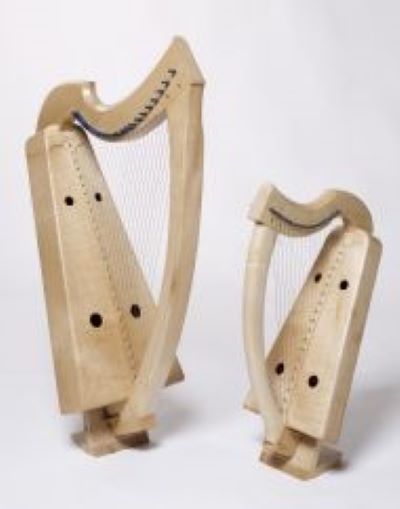(featured image – modern reproductions of historical wire-strung harps, made by Ardival Harps)
The wire-strung harp – or Clàrsach or Cláirseach – has a strong historical presence across the Celtic (Gaelic) world. Associated with elite culture in premodern times, harps and harpers can be found carved into Pictish stones and feature in epic Gaelic poetry. Payment records show harpists at work in the halls of kings and chieftains well into the early modern period. In modern times, however, the instrument has come more to be associated with ‘folk’ music.
Keith Sanger – musician and researcher – here discusses with me recent research into the uses, repertoire and cultural place of the harp in Scotland.
Q: How/why/when did the harp change in function from an ‘elite’ to a ‘folk’ instrument?
The position of the harp in Scotland differed from that in Ireland as both gut and wire-strung harps were in parallel use. However, first the gut-strung and then the wire-strung harp were displaced by the viol, which was then in turn displaced by the violin. This left a clear gap until the first harp revival attempt occurred in conjunction with the Gaelic Mods. After a stop/start period, the Clarsach Society was founded (1931) and their success in promoting the small harp led to the more general ‘folk’ use that is familiar today.
Q: How has recent research changed what was understood about the history of the harp in Scotland?
The idea that the heartland of the wire-strung clarsach was in the north and west of Scotland with strong links to the use of the harp in Ireland is probably the biggest change: this model doesn’t hold for the Scottish context. In Scotland, the status of the clàrsach and Scottish gut-strung harps were similar and unlike Ireland their presence at a Royal Court, at least until 1603, moves the ‘homeland’ of the clarsach to the south and east. It is also clear that first the gut-strung harps and then the wire-strung harps were replaced by viols and then violins.
Some Further Reading
- Sanger, Keith and Alison Kinnaird, Tree of Strings (Crann nan teud): A History of the Harp in Scotland (originally published Temple, Midlothian: Kinmor Music, 1992) republished by Routledge, 2017
- Sanger, Keith, Mapping the Clarsach in Scotland (2017)
- Sanger, Keith, ’A Retrospective look at the research into Scottish harps’, in Harp Perspectives, Cruit Éireann (Feb 2022), 3-10.
- Wire-strung Harp website

